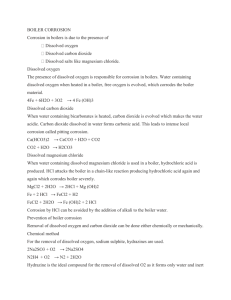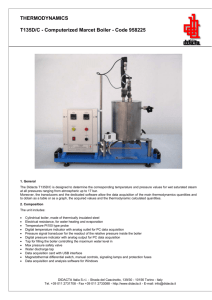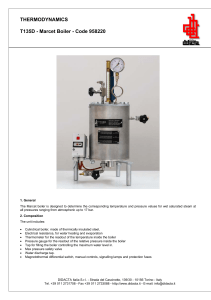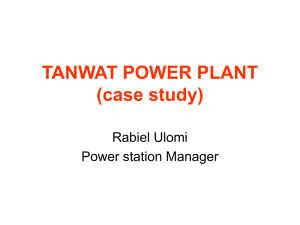BOILER FEED WATER In Industry, one of the chief uses of water is
advertisement
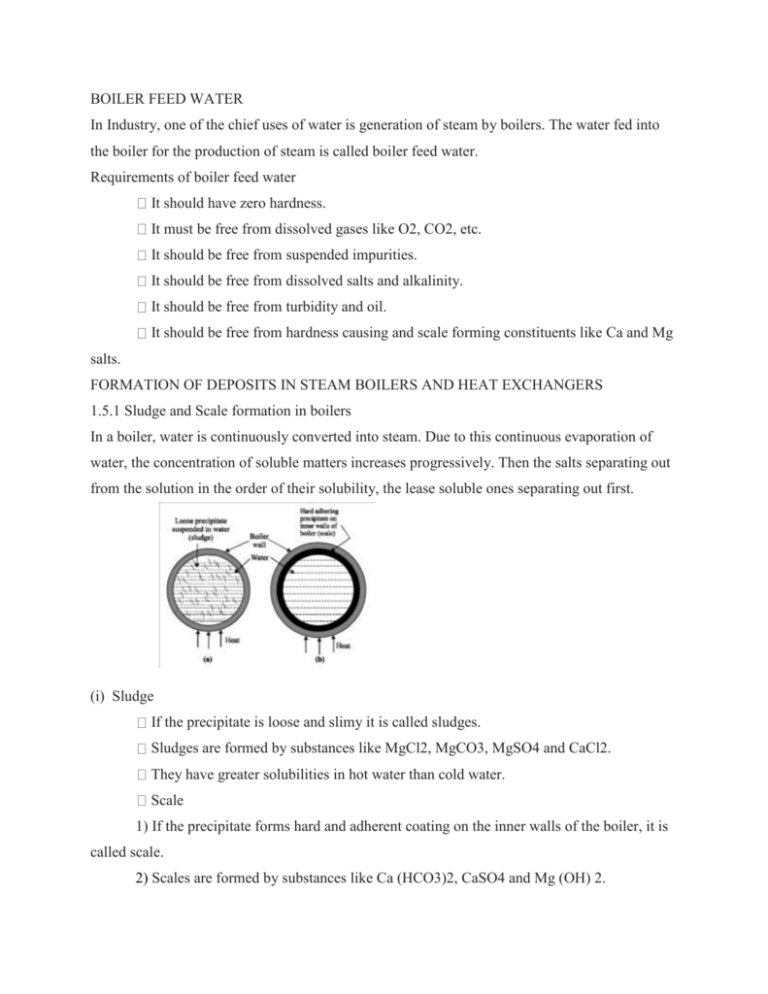
BOILER FEED WATER In Industry, one of the chief uses of water is generation of steam by boilers. The water fed into the boiler for the production of steam is called boiler feed water. Requirements of boiler feed water It should have zero hardness. It must be free from dissolved gases like O2, CO2, etc. It should be free from suspended impurities. It should be free from dissolved salts and alkalinity. It should be free from turbidity and oil. It should be free from hardness causing and scale forming constituents like Ca and Mg salts. FORMATION OF DEPOSITS IN STEAM BOILERS AND HEAT EXCHANGERS 1.5.1 Sludge and Scale formation in boilers In a boiler, water is continuously converted into steam. Due to this continuous evaporation of water, the concentration of soluble matters increases progressively. Then the salts separating out from the solution in the order of their solubility, the lease soluble ones separating out first. (i) Sludge If the precipitate is loose and slimy it is called sludges. Sludges are formed by substances like MgCl2, MgCO3, MgSO4 and CaCl2. They have greater solubilities in hot water than cold water. Scale 1) If the precipitate forms hard and adherent coating on the inner walls of the boiler, it is called scale. 2) Scales are formed by substances like Ca (HCO3)2, CaSO4 and Mg (OH) 2. 1.5.2 Disadvantages (i) Wastage of fuels Scales have a low thermal conductivity, so the rate of heat transfer from boiler to inside water is greatly decreased. In order to provide a supply of heat to water, excessive or over-heating is done. This causes increase in fuel consumption. The wastage of fuel depends upon the thickness and the nature of scale. (ii) Decrease in efficiency Scales sometimes deposit in the valves and condensers of the boiler and choke them partially. This results in decrease in efficiency of the boiler. Boiler explosion When thick scales crack due to uneven expansion, the water comes suddenly in contact with overheated iron plates. This causes in formation of a large amount of steam suddenly. So sudden highpressure is developed, which may even cause explosion of the boiler 1.6 PREVENTION OF SCALE FORMATION (OR) SOFTENING OF HARD WATER The process of removing hardness – producing salts from water is known as softening or conditioning of water. Since water is a source for industrial purpose. It is mandatory to soften water to make it free from hardness producing substances, suspended impurities and dissolved gases, etc. BOILER CORROSION Corrosion in boilers is due to the presence of Dissolved oxygen Dissolved carbon dioxide Dissolved salts like magnesium chloride. Dissolved oxygen The presence of dissolved oxygen is responsible for corrosion in boilers. Water containing dissolved oxygen when heated in a boiler, free oxygen is evolved, which corrodes the boiler material. 4Fe + 6H2O + 3O2 → 4 Fe (OH)3 Dissolved carbon dioxide When water containing bicarbonates is heated, carbon dioxide is evolved which makes the water acidic. Carbon dioxide dissolved in water forms carbonic acid. This leads to intense local corrosion called pitting corrosion. Ca(HCO3)2 → CaCO3 + H2O + CO2 CO2 + H2O → H2CO3 Dissolved magnesium chloride When water containing dissolved magnesium chloride is used in a boiler, hydrochloric acid is produced. HCl attacks the boiler in a chain-like reaction producing hydrochloric acid again and again which corrodes boiler severely. MgCl2 + 2H2O → 2HCl + Mg (OH)2 Fe + 2 HCl → FeCl2 + H2 FeCl2 + 2H2O → Fe (OH)2 + 2 HCl Corrosion by HCl can be avoided by the addition of alkali to the boiler water. Prevention of boiler corrosion Removal of dissolved oxygen and carbon dioxide can be done either chemically or mechanically. Chemical method For the removal of dissolved oxygen, sodium sulphite, hydrazines are used. 2Na2SO3 + O2 → 2Na2SO4 N2H4 + O2 → N2 + 2H2O Hydrazine is the ideal compound for the removal of dissolved O2 as it forms only water and inert nitrogen gas during the reaction. Dissolved CO2 is removed by the addition of ammonium hydroxide. 2NH4OH + CO2 → (NH4)2CO3 + H2O Mechanical method Oxygen along with carbon dioxide can be removed mechanically by the de-aeration method In this method, water is allowed to fill in slowly on the perforated plates fitted inside the tower. To reduce the pressure inside the tower, the de-aerator is connected to a vacuum pump. The sides of the tower are heated by means of a steam jacket. This is based on the principle that the solubility of a gas in water is directly proportional to pressure and inversely proportional to temperature. High temperature, low pressure and a large exposed surface, reduces the dissolved gases (O2 and CO 2) in water. The water flows down through a number of perforated plates and this arrangement exposes a large surface of water for de-aeration. 1.12 PRIMING AND FOAMING (CARRY OVER) During the production of steam in the boiler, due to rapid boiling, some droplets of liquid water are carried along with steam. Steam containing droplets of liquid water is called wet steam. These droplets of liquid water carry with them some dissolved salts and suspended impurities. This phenomenon is called carry over. It occurs due to priming and foaming. Priming Priming is the process of production of wet steam. Priming is caused by High steam velocity. Very high water level in the boiler. Sudden boiling of water. Very poor boiler design. Prevention Priming can be controlled by Controlling the velocity of steam. Keeping the water level lower. Good boiler design. Using treated water. Foaming The formation of stable bubbles above the surface of water is called foaming. These bubbles are carried over by steam leading to excessive priming. Foaming is caused by the Presence of oil and grease. Presence of finely divided particles. Prevention Foaming can be prevented by Adding coagulants like sodium aluminate, aluminium hydroxide. Adding anti-foaming agents like synthetic polyamides.

